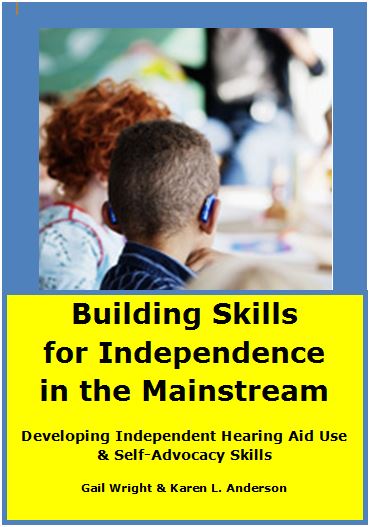Related Products
For Parents
Related Teacher Tools Takeout Items
Strategies for Keeping Hearing Aids on Young Children
 Thank you parents!
Thank you parents!
In 2012, Jane Madell, PhD and I sent out a survey to a variety of groups of parents of children who are hard of hearing or deaf, asking them what strategies they used to keep hearing aids on their children when they were very young. We also asked them to rate the various hearing aid retention accessories that are available. The results provide valuable information for families to know and for audiologists and early intervention professionals to share with the families they support. Jane and I then developed the information into three 2-page brochures that can be provided to families based on the age of their child. Again, thank you parents for sharing your expertise. Karen L. Anderson, PhD, Director.
Downloadable Keeping Hearing Aids On Brochures for Families
The brochures address why and when hearing aids are needed; basic problems keeping hearing aids on for children in that age range; and hearing device retention accessory information. Print out as a two-sided document and fold as a brochure. Provide to families as their child grows throughout early childhood. Audiology clinics and early intervention programs are encouraged to print brochures to have copies readily available for families when hearing aid retention issues are discussed.
Download and print your brochure information now! Select the brochure below and print! Both sides is suggested, using 28# or 30# paper.
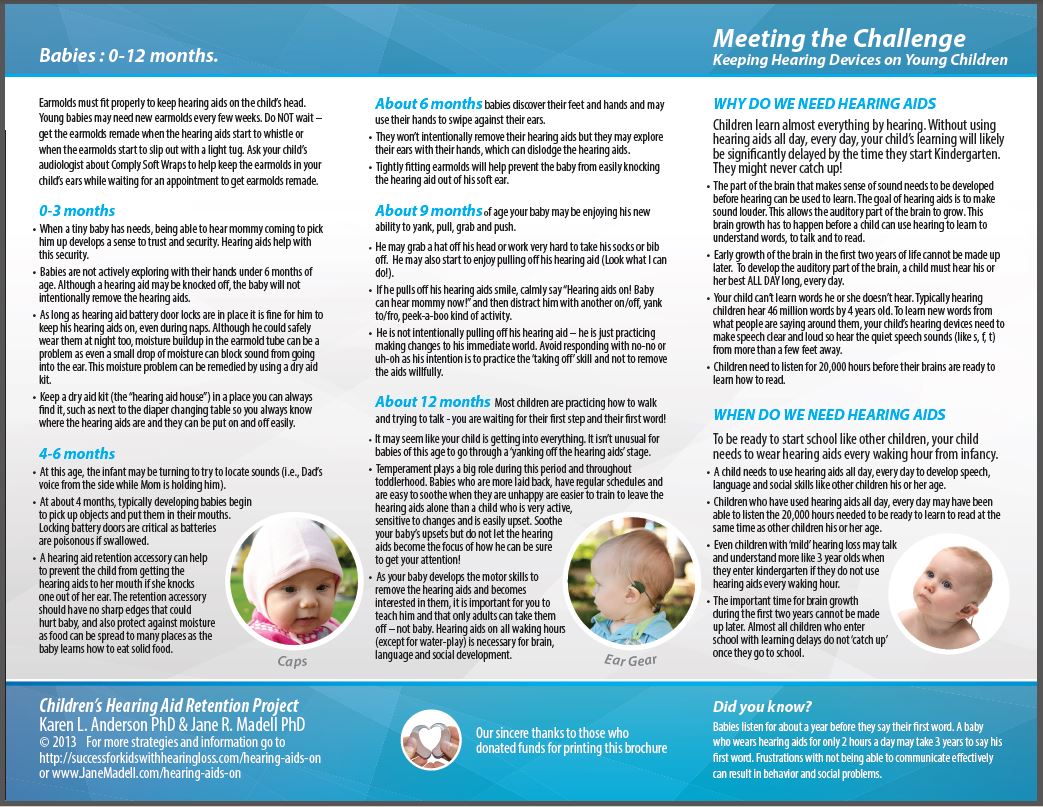 Babies and Hearing Aids – 0-12 Months: 0-3 months; 4-6 months; 6 months; 9 months; 12 months; how to keep hearing aids out of your baby’s mouth; how to discourage his practicing the skill of yanking off the hearing aids
Babies and Hearing Aids – 0-12 Months: 0-3 months; 4-6 months; 6 months; 9 months; 12 months; how to keep hearing aids out of your baby’s mouth; how to discourage his practicing the skill of yanking off the hearing aids
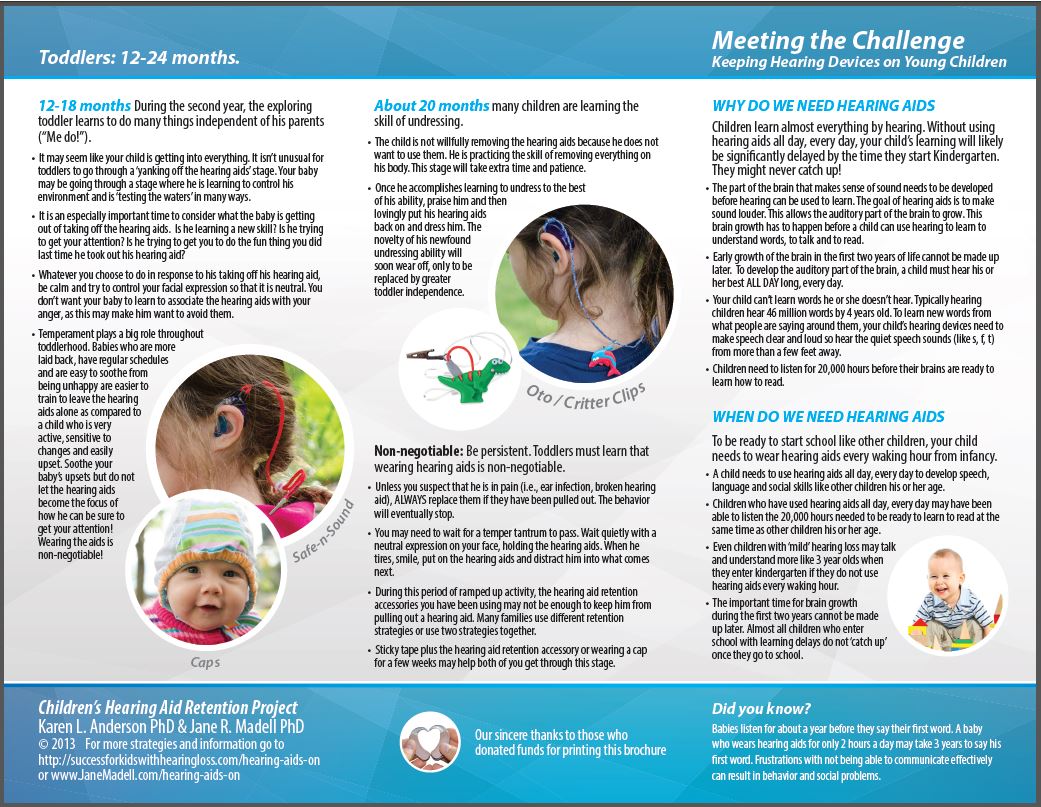 Toddlers 12 to 24 months: during the second year; about 20 months; how to discourage your child from yanking off the hearing aids; checking the hearing aids daily with toddlers
Toddlers 12 to 24 months: during the second year; about 20 months; how to discourage your child from yanking off the hearing aids; checking the hearing aids daily with toddlers
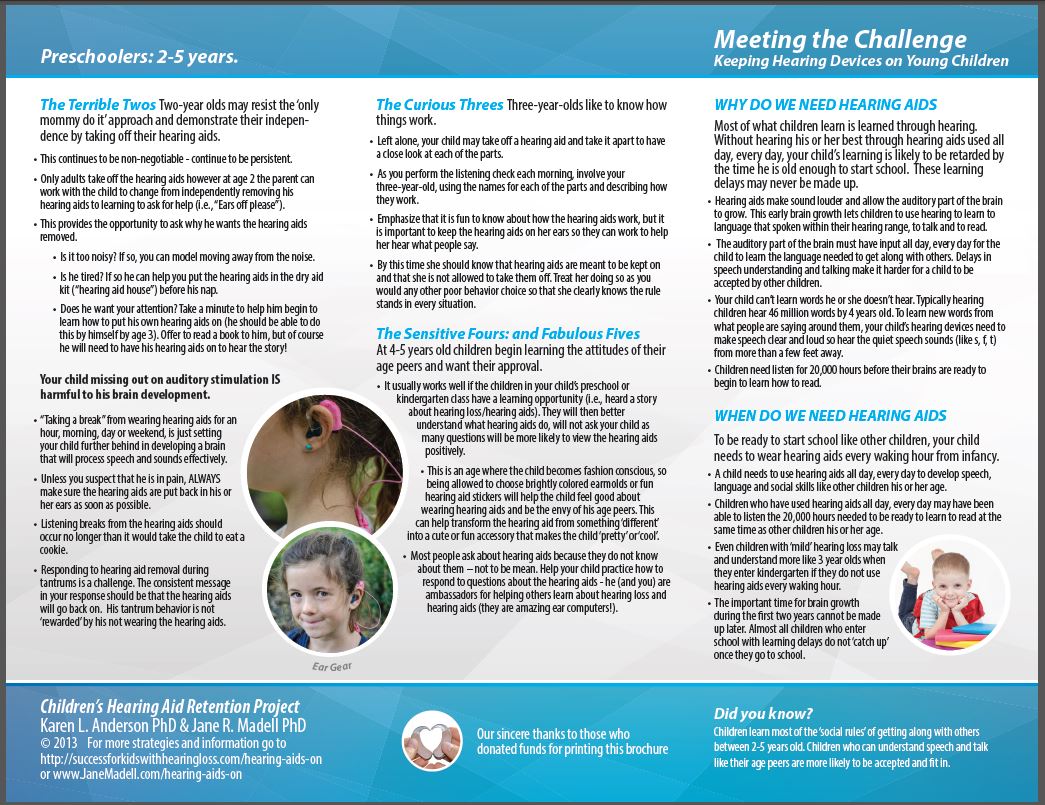 Preschoolers and Hearing Aids – 2-5 Years: the terrible twos; the curious threes; the sensitive fours; checking hearing aids daily with preschoolers
Preschoolers and Hearing Aids – 2-5 Years: the terrible twos; the curious threes; the sensitive fours; checking hearing aids daily with preschoolers
Spanish version of the 3 brochures
Can’t print and want to receive a copy of each brochure by mail? to receive the three brochures, sent in an envelope to you at no cost (English version, US only).
Also available: Oticon USA has made the content of these 3 brochures available in one brochure called the Children’s Retention brochure (#15500-3025). It is available for ordering through pediatrics@oticonusa.com. You can request up to 10 free per order or download them from the Oticon website at: https://www.oticon.com/your-hearing/children-with-hearing-loss/why-childrens-hearing-is-important Spanish version also available! Thanks Oticon!
 Ear Gear was rated top by families for effectiveness for keeping young children’s hearing aids on and safe! Once this finding was evident, a special price was negotiated with Ear Gear for families/professionals who wish to try Ear Gear!
Ear Gear was rated top by families for effectiveness for keeping young children’s hearing aids on and safe! Once this finding was evident, a special price was negotiated with Ear Gear for families/professionals who wish to try Ear Gear!
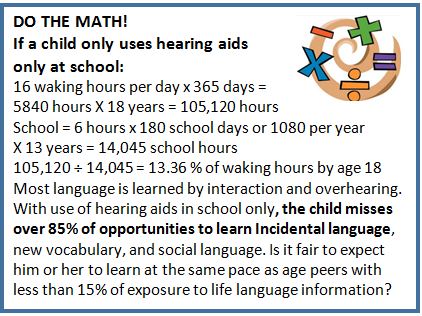 Hearing Review Article: Improving Hearing and Hearing Aid Retention for Infants and Young Children: A practical survey and study of hearing aid retention products. This lead article in the February 2014 Hearing Review is for professionals, describing the survey, results based on parent and audiologist responses and acoustic transparency information for hearing device retention accessories. By Karen Anderson & Jane Madell
Hearing Review Article: Improving Hearing and Hearing Aid Retention for Infants and Young Children: A practical survey and study of hearing aid retention products. This lead article in the February 2014 Hearing Review is for professionals, describing the survey, results based on parent and audiologist responses and acoustic transparency information for hearing device retention accessories. By Karen Anderson & Jane Madell- Advance for Speech and Hearing article: If We Could Improve Just One Thing: Getting the Most Out of Early Hearing Loss Identification, by Karen Anderson is an easy to read summary of the information, appropriate for professionals and families.
- Hearing Aid Retention for Infants and Young Children: Jane Madell & Karen Anderson, Volta Review Article, Sept/Oct, 2014. For families describing the Children’s Hearing Aid Retention Project survey and results.
- Understanding Limited Use of Amplification in Infants and Children who are Hard of Hearing: Ryan McCreery, Elizabeth Walker & Meredith Spratford. ASHA SIG 9 Perspectives in Hearing and Hearing Disorders in Children, 25, 15-23
- Hearing Aid Use for Children with Hearing Loss: A Literature Review: Karen Munoz & Melanie Hill. ASHA SIG 9 Perspectives in Hearing and Hearing Disorders in Children, 25, 4-14.
- Trends and Predictors of Longitudinal Hearing Aid Use for Children Who are Hard of Hearing: Walker, EA, McCreery, RW, Spratford, M. Ear and Hearing, 36(Supplement 1), Nov/Dec 2015.
Summary information on hearing aid retention survey results and acoustic transparency click here
When the kids were little, one of the strategies we used to keep their aids in their ears was to let them decorate their aids with stickers, charms, and colorful tubes. Letting them personalize their aids was a great way to help them connect with their aids and make them their own. Parent of two children with hearing loss.
Parent’s Strategies Supporting Full-Time Hearing Aid Wear
What helps parents understand their child’s need to use hearing devices all his/her waking hours:
- Talking with other families that had children with hearing loss.
- Speaking with an adult or older child that has hearing loss/hearing aids/cochlear implants and/or viewing videos on the internet of these individuals describing their experiences/abilities.
- Understanding that early exposure to hearing actually develops structures in the brain that allows sound to be processed so it is meaningful – this time cannot be made up at a later age.
- Watching my child’s reaction to sound around him when he wears his hearing aids.
- Recognizing that children will not learn to language to speak or speak clearly until they can hear the speech sounds clearly and that these delays will affect readiness for school.
- The “math” of hearing aids: Babies listen for about a year before they say their first word. If a baby with hearing loss is awake for 8 hours day and only wears hearing aids for 2 hours then he will only be able to ‘tune in’ to the hearing world 25% of the time. It may take up to 4 years for his first word. A school-aged child is awake about 100 hours/week. If he only wears hearing aids in school, that is about 30 hours/week. If the child is only wearing hearing aids 30% of the time then the students can expect 30% achievement since listening and language development occurs all waking hours.
- Learning more about hearing loss by listening to simulations of my child’s hearing ability.
- Getting over my fear of putting the hearing aids into his ears and how to check them daily.
Parent strategies for keeping the hearing aids on the young child’s head:
- Put the hearing aids on first thing in the morning so they felt normal on the head; never, never take a day off!
- Sing whenever the child pulls off the hearing aid; child will want to ‘hear music’.
- Cap over the hearing aids with strings under the child’s chin, crisscrossed and then tied behind the neck so the child cannot easily untie the strings and pull the cap off.
- Clips to hearing aids attached to barrettes in hair; if child pulls off hearing aids it also pulls hair.
- Snugly fitting earmolds that have a tube that fits around the outer ear to make the hearing aid harder for the child to yank off the ear; cement the tubes into the earmolds.
- Toupee tape to help support a large hearing aid or FM + hearing aid on a tiny ear. Suggestions for tape:
- Topstic – pre-cut strips
- Phonak hearing aids Stick’n Stay – shaped like hearing aids
- Hollywood Fashion Tape – can come in already pre cut strips and less abrasive than some wig tapes (from Amazon, Target, Walgreens, etc.)
- Use clips to the back of the child’s shirt or collar – even if he pulls out the hearing aids at least they won’t get lost
- Combine Ear Gear and toupee tape.
- Tube Rider collection as a fun way to keep a child interested and proud of her hearing aids.
- Make sure your child’s day care provider keeps the hearing aids on at all times. If you pick your child up and consistently notice that the hearing aids are off, find a new child care provider.
- Brightly colored earmolds and Ear Gear or SafeNSound name straps that the child can ‘show off’.
- Children are more likely to try to pull of their hearing aids if their hands aren’t busy doing something else!
- It helps to know that all children go through a phase where they take off their hearing aids. Persistence in putting them back in, using accessories to keep them on the child’s head and keeping the child distracted and ‘happily listening’ helps to get through these trying periods.
- Different strategies are needed as children’s dexterity changes. Tape/clips/Ear Gear alone or in combination.
Parent strategies for keeping the cochlear implant speech processor on the young child’s head:
- Sew baby socks on his undershirts for the battery packs of his CI.
- Snug-fitting caps or headbands to keep the headpiece/processor on the head.
- Taping the CI head piece with medical tape to his head – if he yanked it off it would pull a bit of hair as a deterrent.
Strategies for keeping devices on the child’s head while in the car:
- Wrap a blanket around her that has a Velcro strip so she can’t bend her elbows while she es in her carseat (only need to do this a week or less before most children won’t bother the aids anymore).
- Mittens! Use suspender clips and elastic and put through his coat sleeves. That way the mittens are always handy and it is more of a challenge for him to get them off. When he was concentrating on the mittens, he was leaving the hearing aids alone.
- Short Pringle can tubes over his elbows so it made it hard for her to reach her ears. Place special ‘car toys’ that she especially likes in her reach. They are only kept in the car so she will look forward to playing quietly in her seat.
- Inflatable “water wings” over his elbows.
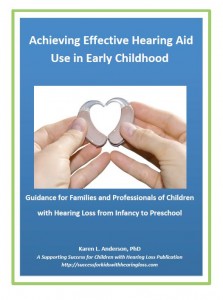
Need more information to help your child or support families better? Consider Achieving Effective Hearing Aid Use in Early Childhood, an in depth 80-page guide by Karen Anderson, PhD.
Parents may be interested in:
One-page handouts: Relationship of Hearing Loss to Listening and Learning Needs
- 16—25 dB Hearing Loss
- 26 — 40 dB Hearing Loss
- 41 — 55 dB Hearing Loss
- 56 — 70 dB Hearing Loss
- 71 — 90+ dB Hearing Loss
- Unilateral Hearing Loss
- Fluctuating Hearing Loss
- High Frequency Hearing Loss
- Reverse Slope or Mid—Frequency Hearing Loss
- Spanish version of Relationship of Hearing Loss to Listening and Learning Needs, all handouts together
Parents may also be interested in:
Communication Building Blocks There are a multitude of resources available that describe the different communication choices or continuum of communication modalities that may be used by children and their communication partners to develop language. This resource presents different aspects of communication as building blocks that can be combined and recombined based on the child’s learning style, desired mode of the family and changing communication situations. It is meant to introduce the concept of communication choices in an unbiased manner and emphasizes that any choice of communication modality can change as the child develops.
choices or continuum of communication modalities that may be used by children and their communication partners to develop language. This resource presents different aspects of communication as building blocks that can be combined and recombined based on the child’s learning style, desired mode of the family and changing communication situations. It is meant to introduce the concept of communication choices in an unbiased manner and emphasizes that any choice of communication modality can change as the child develops.
Updated January 2016.




